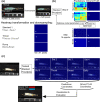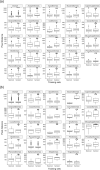Using pose estimation to identify regions and points on natural history specimens
- PMID: 36812227
- PMCID: PMC9987800
- DOI: 10.1371/journal.pcbi.1010933
Using pose estimation to identify regions and points on natural history specimens
Abstract
A key challenge in mobilising growing numbers of digitised biological specimens for scientific research is finding high-throughput methods to extract phenotypic measurements on these datasets. In this paper, we test a pose estimation approach based on Deep Learning capable of accurately placing point labels to identify key locations on specimen images. We then apply the approach to two distinct challenges that each requires identification of key features in a 2D image: (i) identifying body region-specific plumage colouration on avian specimens and (ii) measuring morphometric shape variation in Littorina snail shells. For the avian dataset, 95% of images are correctly labelled and colour measurements derived from these predicted points are highly correlated with human-based measurements. For the Littorina dataset, more than 95% of landmarks were accurately placed relative to expert-labelled landmarks and predicted landmarks reliably captured shape variation between two distinct shell ecotypes ('crab' vs 'wave'). Overall, our study shows that pose estimation based on Deep Learning can generate high-quality and high-throughput point-based measurements for digitised image-based biodiversity datasets and could mark a step change in the mobilisation of such data. We also provide general guidelines for using pose estimation methods on large-scale biological datasets.
Copyright: © 2023 He et al. This is an open access article distributed under the terms of the Creative Commons Attribution License, which permits unrestricted use, distribution, and reproduction in any medium, provided the original author and source are credited.
Conflict of interest statement
The authors have declared that no competing interests exist.
Figures








References
-
- Lürig MD, Donoughe S, Svensson EI, Porto A, Tsuboi M. Computer Vision, Machine Learning, and the Promise of Phenomics in Ecology and Evolutionary Biology. Frontiers in Ecology and Evolution. 2021;9(April).
-
- Ariño A. Approaches to estimating the universe of natural history collections data. Biodiversity Informatics. 2010;7(2):81–92.
Publication types
MeSH terms
LinkOut - more resources
Full Text Sources
Research Materials

